Financial Reporting: IFRS, IAS, and Stakeholder Analysis
VerifiedAdded on 2021/02/21
|15
|3926
|324
Report
AI Summary
This report provides a comprehensive overview of International Financial Reporting Standards (IFRS). It begins by explaining the context and purpose of financial reporting, including its role in transforming raw data into relevant information for stakeholders and management. The report then delves into the conceptual and regulatory frameworks underpinning financial reporting, emphasizing key principles and qualitative characteristics like timeliness, relevance, and faithful representation. It identifies the main stakeholders, differentiating between internal (equity holders, employees) and external (investors, creditors, government) groups, and explores how financial information benefits each group. The report further examines the value of financial reporting in achieving business objectives and fostering growth, including its role in managerial decision-making and organizational development. It presents and analyzes the main financial statements, including the Profit and Loss Account, Statement of Changes in Equity, and Statement of Financial Position. The report also covers the interpretation and communication of financial performance using profitability ratios, and highlights the differences between IAS and IFRS. It concludes by discussing the advantages of the international financial reporting system and the degree of compliance with IFRS.
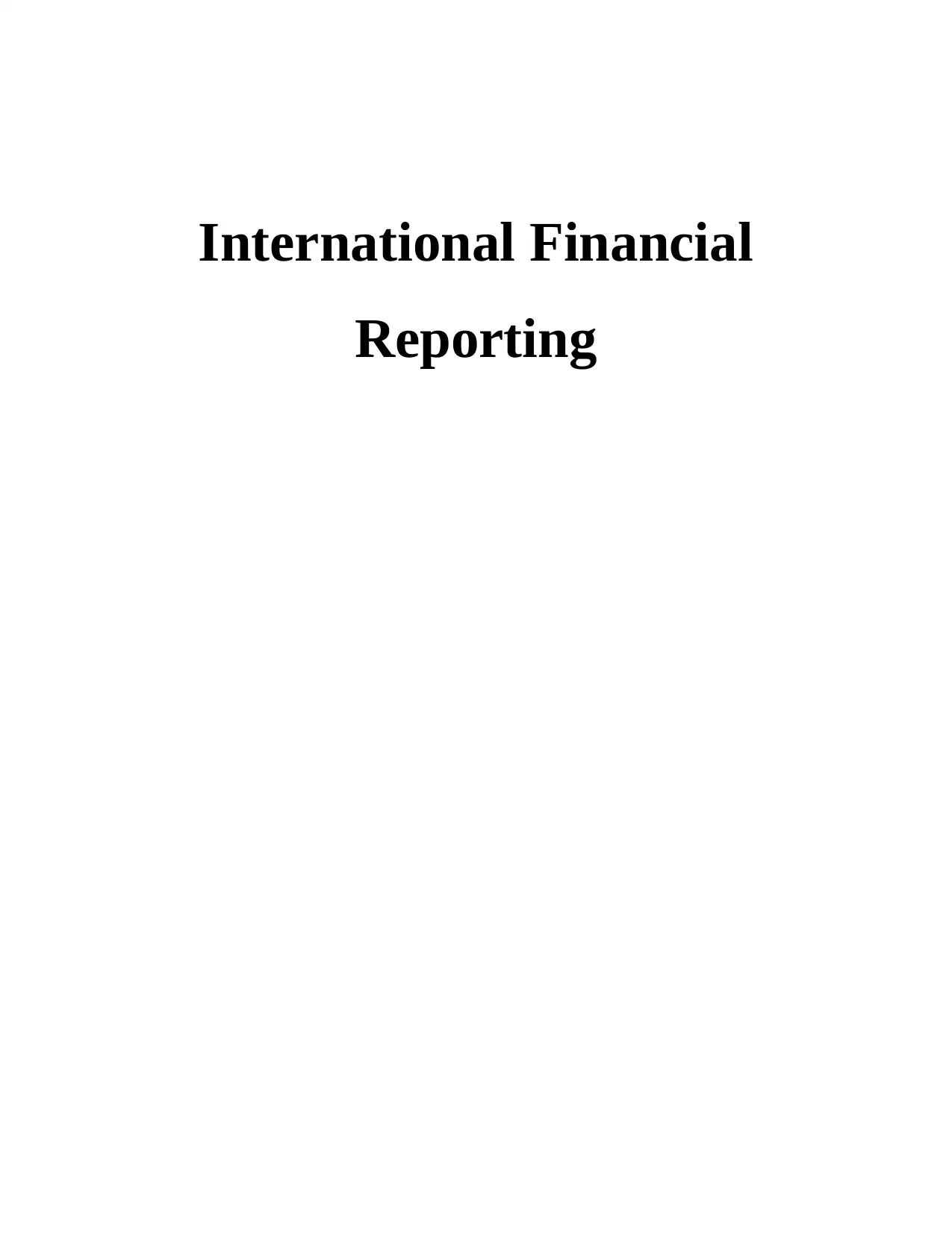
International Financial
Reporting
Reporting
Paraphrase This Document
Need a fresh take? Get an instant paraphrase of this document with our AI Paraphraser
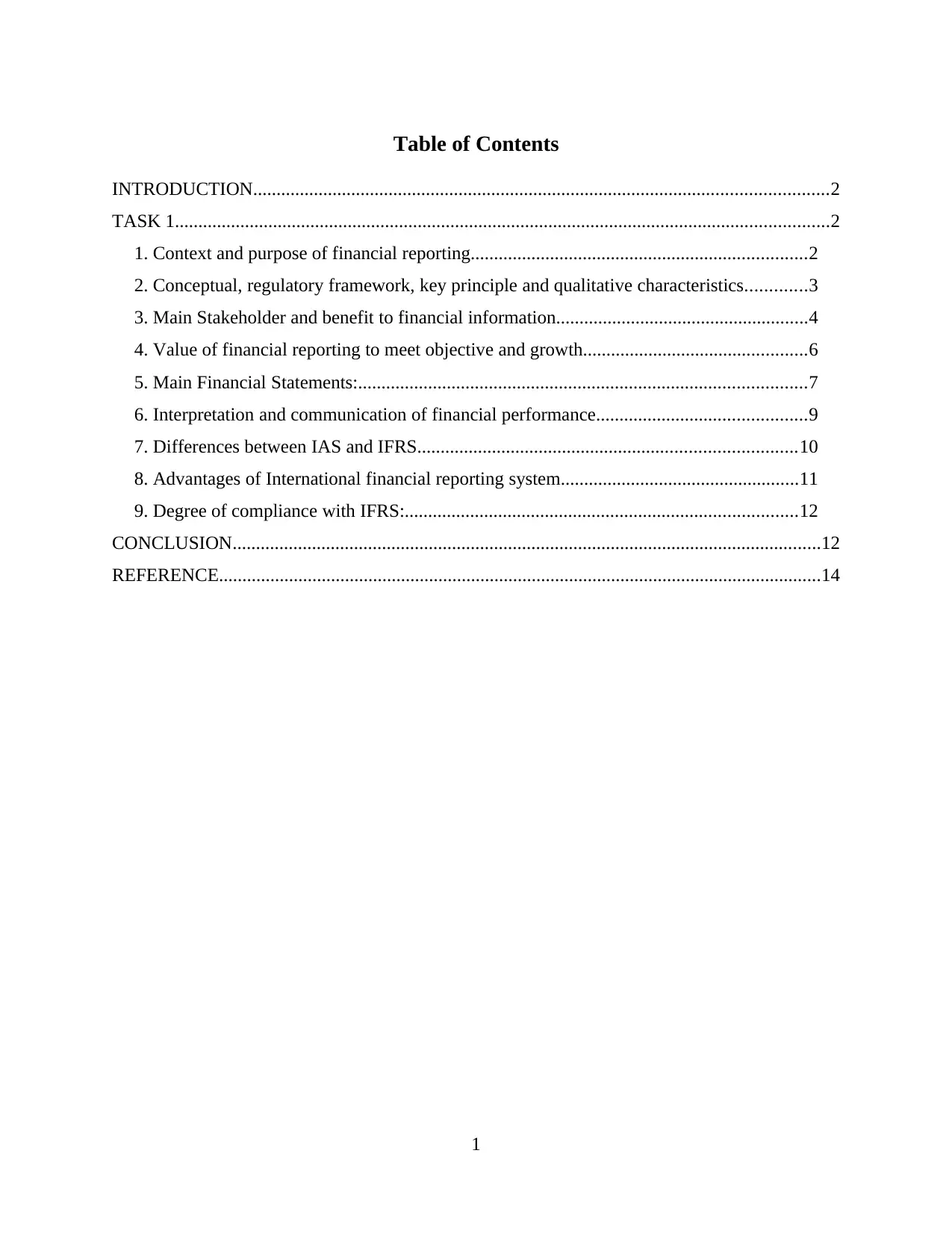
Table of Contents
INTRODUCTION...........................................................................................................................2
TASK 1............................................................................................................................................2
1. Context and purpose of financial reporting........................................................................2
2. Conceptual, regulatory framework, key principle and qualitative characteristics.............3
3. Main Stakeholder and benefit to financial information......................................................4
4. Value of financial reporting to meet objective and growth................................................6
5. Main Financial Statements:................................................................................................7
6. Interpretation and communication of financial performance.............................................9
7. Differences between IAS and IFRS.................................................................................10
8. Advantages of International financial reporting system...................................................11
9. Degree of compliance with IFRS:....................................................................................12
CONCLUSION..............................................................................................................................12
REFERENCE.................................................................................................................................14
1
INTRODUCTION...........................................................................................................................2
TASK 1............................................................................................................................................2
1. Context and purpose of financial reporting........................................................................2
2. Conceptual, regulatory framework, key principle and qualitative characteristics.............3
3. Main Stakeholder and benefit to financial information......................................................4
4. Value of financial reporting to meet objective and growth................................................6
5. Main Financial Statements:................................................................................................7
6. Interpretation and communication of financial performance.............................................9
7. Differences between IAS and IFRS.................................................................................10
8. Advantages of International financial reporting system...................................................11
9. Degree of compliance with IFRS:....................................................................................12
CONCLUSION..............................................................................................................................12
REFERENCE.................................................................................................................................14
1
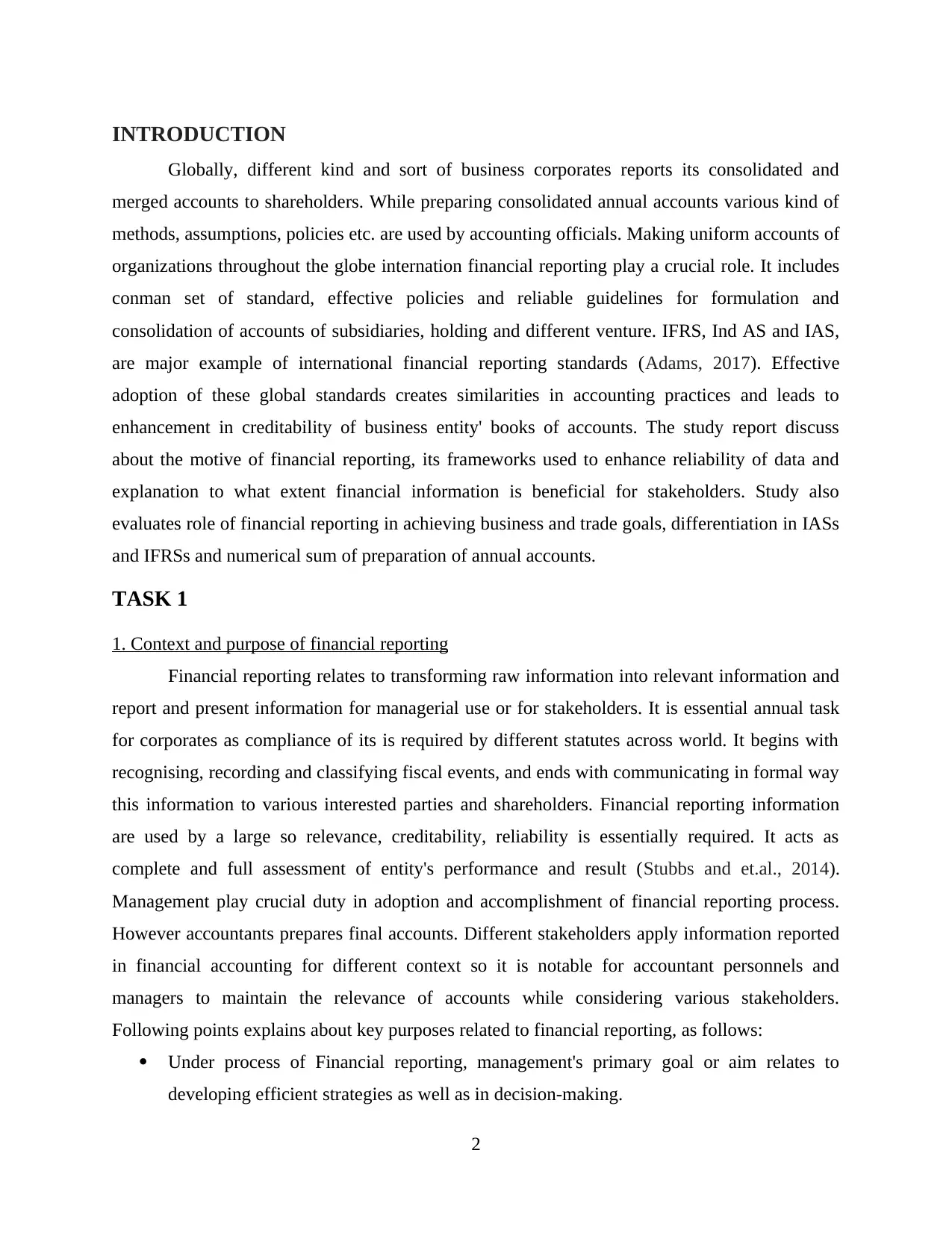
INTRODUCTION
Globally, different kind and sort of business corporates reports its consolidated and
merged accounts to shareholders. While preparing consolidated annual accounts various kind of
methods, assumptions, policies etc. are used by accounting officials. Making uniform accounts of
organizations throughout the globe internation financial reporting play a crucial role. It includes
conman set of standard, effective policies and reliable guidelines for formulation and
consolidation of accounts of subsidiaries, holding and different venture. IFRS, Ind AS and IAS,
are major example of international financial reporting standards (Adams, 2017). Effective
adoption of these global standards creates similarities in accounting practices and leads to
enhancement in creditability of business entity' books of accounts. The study report discuss
about the motive of financial reporting, its frameworks used to enhance reliability of data and
explanation to what extent financial information is beneficial for stakeholders. Study also
evaluates role of financial reporting in achieving business and trade goals, differentiation in IASs
and IFRSs and numerical sum of preparation of annual accounts.
TASK 1
1. Context and purpose of financial reporting
Financial reporting relates to transforming raw information into relevant information and
report and present information for managerial use or for stakeholders. It is essential annual task
for corporates as compliance of its is required by different statutes across world. It begins with
recognising, recording and classifying fiscal events, and ends with communicating in formal way
this information to various interested parties and shareholders. Financial reporting information
are used by a large so relevance, creditability, reliability is essentially required. It acts as
complete and full assessment of entity's performance and result (Stubbs and et.al., 2014).
Management play crucial duty in adoption and accomplishment of financial reporting process.
However accountants prepares final accounts. Different stakeholders apply information reported
in financial accounting for different context so it is notable for accountant personnels and
managers to maintain the relevance of accounts while considering various stakeholders.
Following points explains about key purposes related to financial reporting, as follows:
Under process of Financial reporting, management's primary goal or aim relates to
developing efficient strategies as well as in decision-making.
2
Globally, different kind and sort of business corporates reports its consolidated and
merged accounts to shareholders. While preparing consolidated annual accounts various kind of
methods, assumptions, policies etc. are used by accounting officials. Making uniform accounts of
organizations throughout the globe internation financial reporting play a crucial role. It includes
conman set of standard, effective policies and reliable guidelines for formulation and
consolidation of accounts of subsidiaries, holding and different venture. IFRS, Ind AS and IAS,
are major example of international financial reporting standards (Adams, 2017). Effective
adoption of these global standards creates similarities in accounting practices and leads to
enhancement in creditability of business entity' books of accounts. The study report discuss
about the motive of financial reporting, its frameworks used to enhance reliability of data and
explanation to what extent financial information is beneficial for stakeholders. Study also
evaluates role of financial reporting in achieving business and trade goals, differentiation in IASs
and IFRSs and numerical sum of preparation of annual accounts.
TASK 1
1. Context and purpose of financial reporting
Financial reporting relates to transforming raw information into relevant information and
report and present information for managerial use or for stakeholders. It is essential annual task
for corporates as compliance of its is required by different statutes across world. It begins with
recognising, recording and classifying fiscal events, and ends with communicating in formal way
this information to various interested parties and shareholders. Financial reporting information
are used by a large so relevance, creditability, reliability is essentially required. It acts as
complete and full assessment of entity's performance and result (Stubbs and et.al., 2014).
Management play crucial duty in adoption and accomplishment of financial reporting process.
However accountants prepares final accounts. Different stakeholders apply information reported
in financial accounting for different context so it is notable for accountant personnels and
managers to maintain the relevance of accounts while considering various stakeholders.
Following points explains about key purposes related to financial reporting, as follows:
Under process of Financial reporting, management's primary goal or aim relates to
developing efficient strategies as well as in decision-making.
2
⊘ This is a preview!⊘
Do you want full access?
Subscribe today to unlock all pages.

Trusted by 1+ million students worldwide
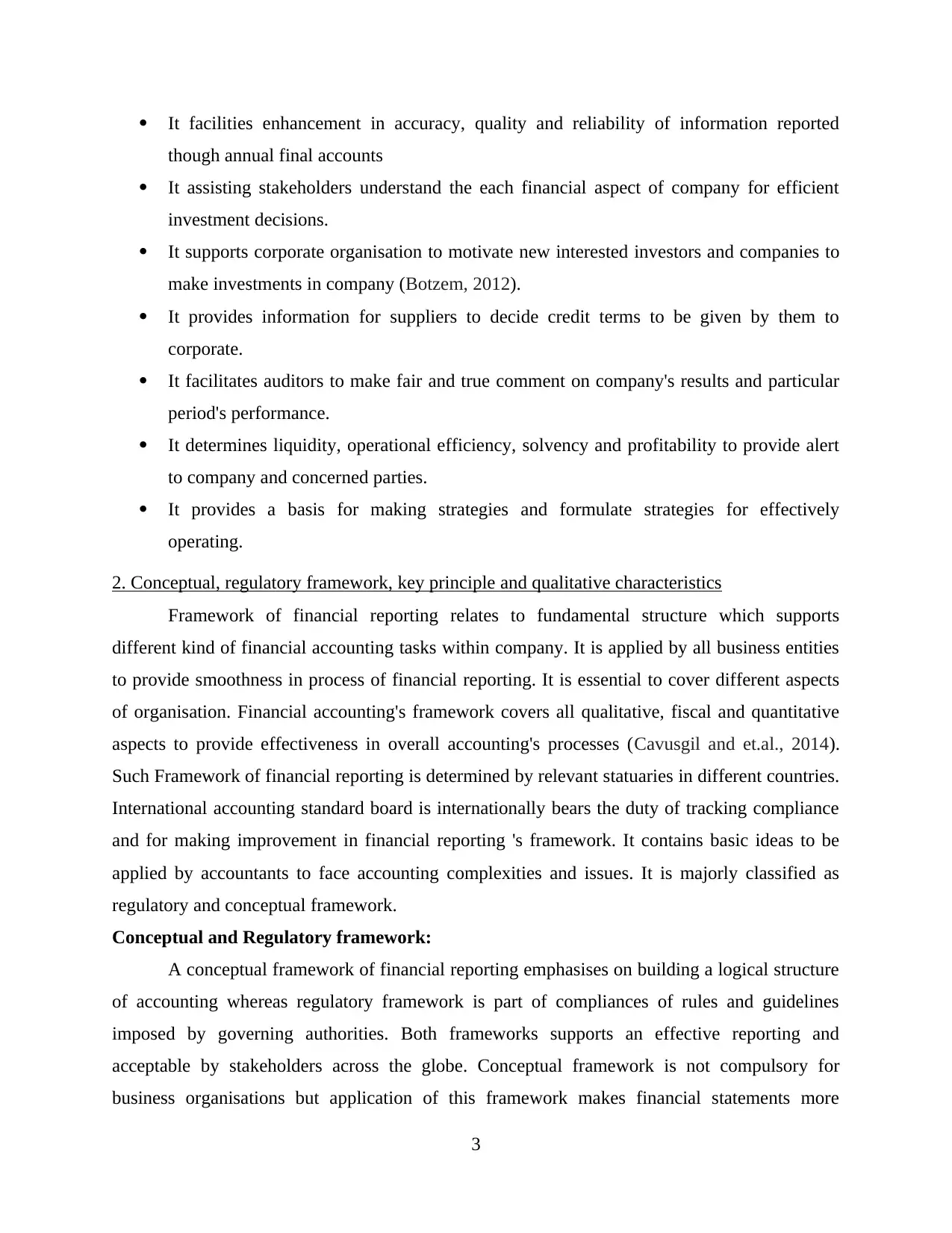
It facilities enhancement in accuracy, quality and reliability of information reported
though annual final accounts
It assisting stakeholders understand the each financial aspect of company for efficient
investment decisions.
It supports corporate organisation to motivate new interested investors and companies to
make investments in company (Botzem, 2012).
It provides information for suppliers to decide credit terms to be given by them to
corporate.
It facilitates auditors to make fair and true comment on company's results and particular
period's performance.
It determines liquidity, operational efficiency, solvency and profitability to provide alert
to company and concerned parties.
It provides a basis for making strategies and formulate strategies for effectively
operating.
2. Conceptual, regulatory framework, key principle and qualitative characteristics
Framework of financial reporting relates to fundamental structure which supports
different kind of financial accounting tasks within company. It is applied by all business entities
to provide smoothness in process of financial reporting. It is essential to cover different aspects
of organisation. Financial accounting's framework covers all qualitative, fiscal and quantitative
aspects to provide effectiveness in overall accounting's processes (Cavusgil and et.al., 2014).
Such Framework of financial reporting is determined by relevant statuaries in different countries.
International accounting standard board is internationally bears the duty of tracking compliance
and for making improvement in financial reporting 's framework. It contains basic ideas to be
applied by accountants to face accounting complexities and issues. It is majorly classified as
regulatory and conceptual framework.
Conceptual and Regulatory framework:
A conceptual framework of financial reporting emphasises on building a logical structure
of accounting whereas regulatory framework is part of compliances of rules and guidelines
imposed by governing authorities. Both frameworks supports an effective reporting and
acceptable by stakeholders across the globe. Conceptual framework is not compulsory for
business organisations but application of this framework makes financial statements more
3
though annual final accounts
It assisting stakeholders understand the each financial aspect of company for efficient
investment decisions.
It supports corporate organisation to motivate new interested investors and companies to
make investments in company (Botzem, 2012).
It provides information for suppliers to decide credit terms to be given by them to
corporate.
It facilitates auditors to make fair and true comment on company's results and particular
period's performance.
It determines liquidity, operational efficiency, solvency and profitability to provide alert
to company and concerned parties.
It provides a basis for making strategies and formulate strategies for effectively
operating.
2. Conceptual, regulatory framework, key principle and qualitative characteristics
Framework of financial reporting relates to fundamental structure which supports
different kind of financial accounting tasks within company. It is applied by all business entities
to provide smoothness in process of financial reporting. It is essential to cover different aspects
of organisation. Financial accounting's framework covers all qualitative, fiscal and quantitative
aspects to provide effectiveness in overall accounting's processes (Cavusgil and et.al., 2014).
Such Framework of financial reporting is determined by relevant statuaries in different countries.
International accounting standard board is internationally bears the duty of tracking compliance
and for making improvement in financial reporting 's framework. It contains basic ideas to be
applied by accountants to face accounting complexities and issues. It is majorly classified as
regulatory and conceptual framework.
Conceptual and Regulatory framework:
A conceptual framework of financial reporting emphasises on building a logical structure
of accounting whereas regulatory framework is part of compliances of rules and guidelines
imposed by governing authorities. Both frameworks supports an effective reporting and
acceptable by stakeholders across the globe. Conceptual framework is not compulsory for
business organisations but application of this framework makes financial statements more
3
Paraphrase This Document
Need a fresh take? Get an instant paraphrase of this document with our AI Paraphraser
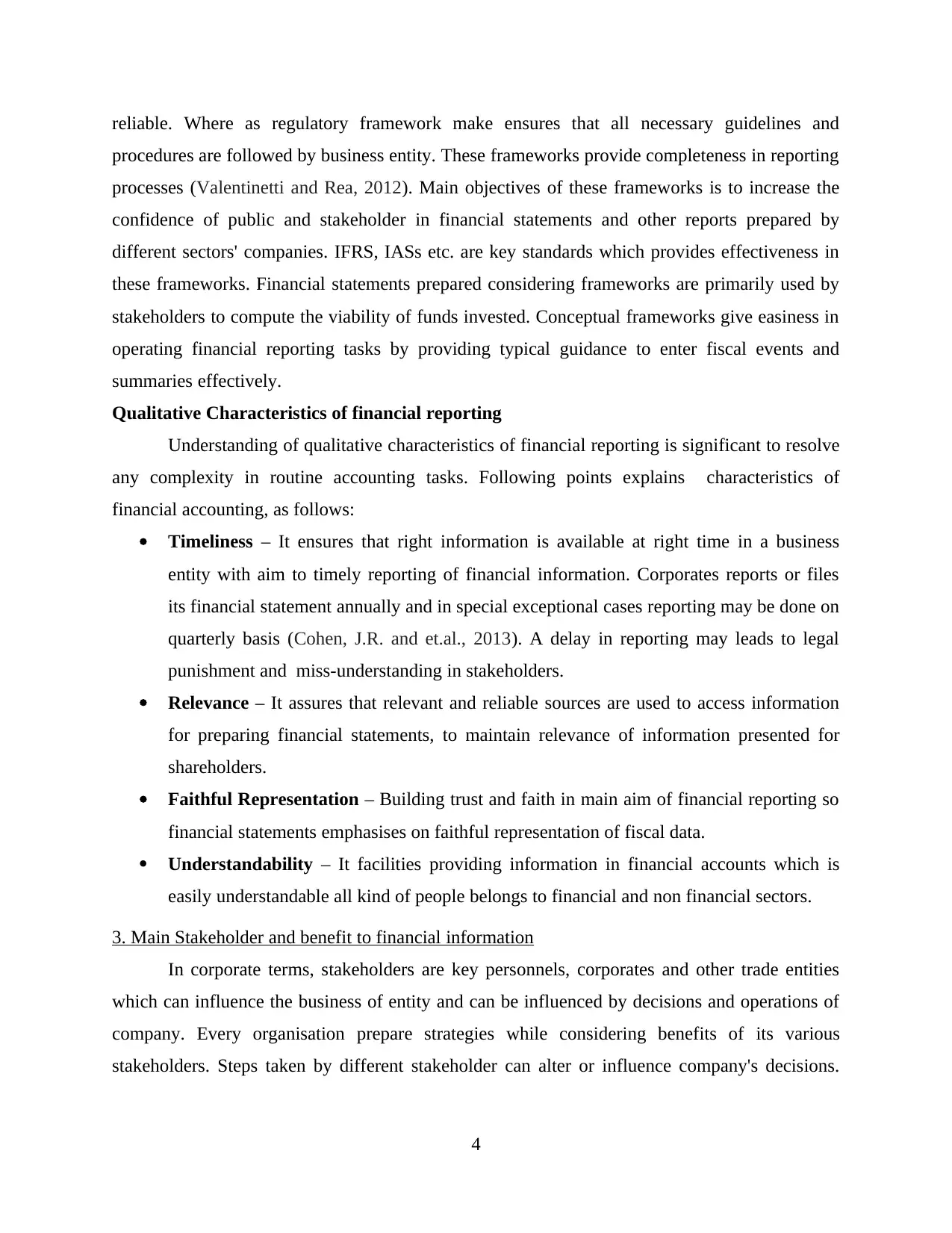
reliable. Where as regulatory framework make ensures that all necessary guidelines and
procedures are followed by business entity. These frameworks provide completeness in reporting
processes (Valentinetti and Rea, 2012). Main objectives of these frameworks is to increase the
confidence of public and stakeholder in financial statements and other reports prepared by
different sectors' companies. IFRS, IASs etc. are key standards which provides effectiveness in
these frameworks. Financial statements prepared considering frameworks are primarily used by
stakeholders to compute the viability of funds invested. Conceptual frameworks give easiness in
operating financial reporting tasks by providing typical guidance to enter fiscal events and
summaries effectively.
Qualitative Characteristics of financial reporting
Understanding of qualitative characteristics of financial reporting is significant to resolve
any complexity in routine accounting tasks. Following points explains characteristics of
financial accounting, as follows:
Timeliness – It ensures that right information is available at right time in a business
entity with aim to timely reporting of financial information. Corporates reports or files
its financial statement annually and in special exceptional cases reporting may be done on
quarterly basis (Cohen, J.R. and et.al., 2013). A delay in reporting may leads to legal
punishment and miss-understanding in stakeholders.
Relevance – It assures that relevant and reliable sources are used to access information
for preparing financial statements, to maintain relevance of information presented for
shareholders.
Faithful Representation – Building trust and faith in main aim of financial reporting so
financial statements emphasises on faithful representation of fiscal data.
Understandability – It facilities providing information in financial accounts which is
easily understandable all kind of people belongs to financial and non financial sectors.
3. Main Stakeholder and benefit to financial information
In corporate terms, stakeholders are key personnels, corporates and other trade entities
which can influence the business of entity and can be influenced by decisions and operations of
company. Every organisation prepare strategies while considering benefits of its various
stakeholders. Steps taken by different stakeholder can alter or influence company's decisions.
4
procedures are followed by business entity. These frameworks provide completeness in reporting
processes (Valentinetti and Rea, 2012). Main objectives of these frameworks is to increase the
confidence of public and stakeholder in financial statements and other reports prepared by
different sectors' companies. IFRS, IASs etc. are key standards which provides effectiveness in
these frameworks. Financial statements prepared considering frameworks are primarily used by
stakeholders to compute the viability of funds invested. Conceptual frameworks give easiness in
operating financial reporting tasks by providing typical guidance to enter fiscal events and
summaries effectively.
Qualitative Characteristics of financial reporting
Understanding of qualitative characteristics of financial reporting is significant to resolve
any complexity in routine accounting tasks. Following points explains characteristics of
financial accounting, as follows:
Timeliness – It ensures that right information is available at right time in a business
entity with aim to timely reporting of financial information. Corporates reports or files
its financial statement annually and in special exceptional cases reporting may be done on
quarterly basis (Cohen, J.R. and et.al., 2013). A delay in reporting may leads to legal
punishment and miss-understanding in stakeholders.
Relevance – It assures that relevant and reliable sources are used to access information
for preparing financial statements, to maintain relevance of information presented for
shareholders.
Faithful Representation – Building trust and faith in main aim of financial reporting so
financial statements emphasises on faithful representation of fiscal data.
Understandability – It facilities providing information in financial accounts which is
easily understandable all kind of people belongs to financial and non financial sectors.
3. Main Stakeholder and benefit to financial information
In corporate terms, stakeholders are key personnels, corporates and other trade entities
which can influence the business of entity and can be influenced by decisions and operations of
company. Every organisation prepare strategies while considering benefits of its various
stakeholders. Steps taken by different stakeholder can alter or influence company's decisions.
4
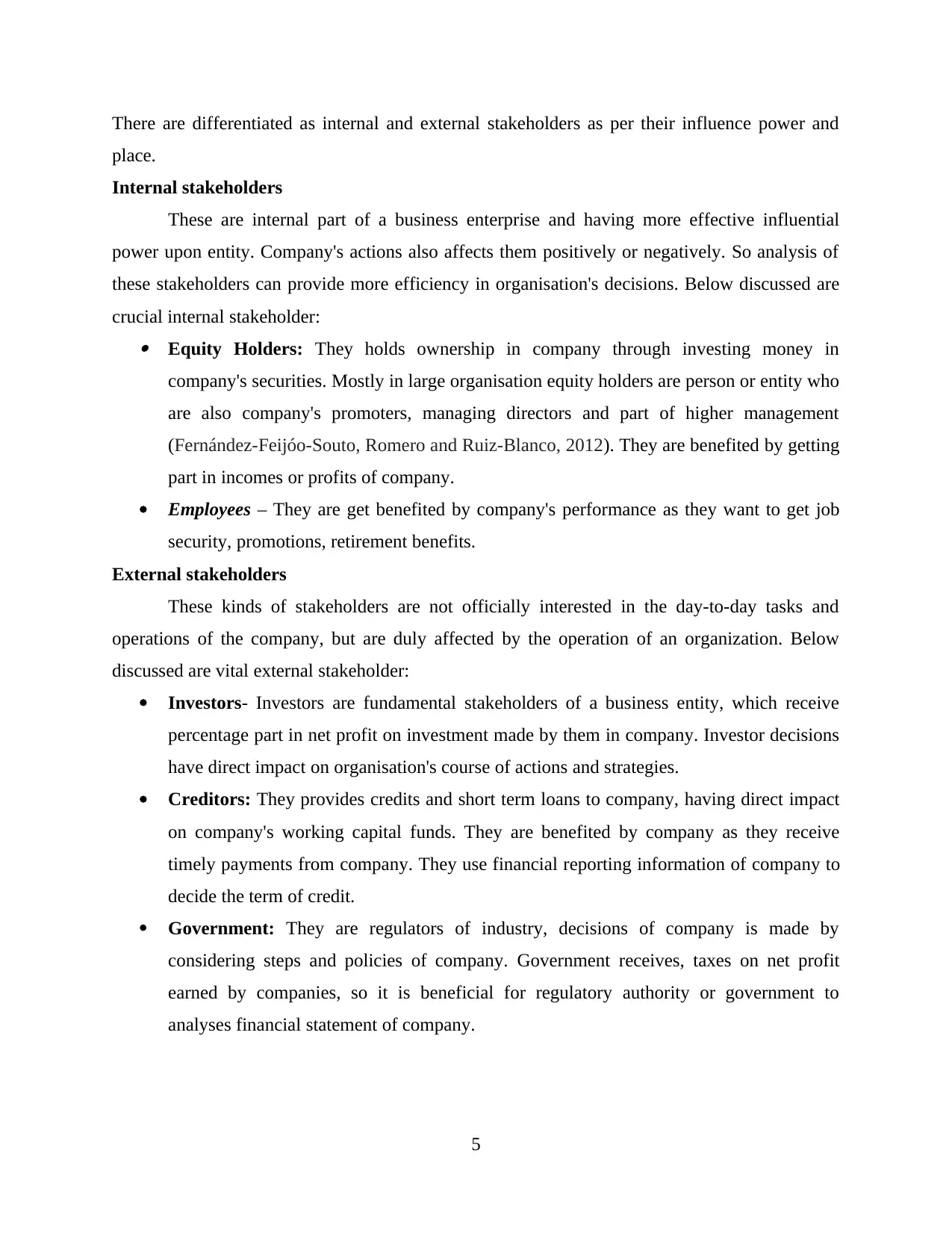
There are differentiated as internal and external stakeholders as per their influence power and
place.
Internal stakeholders
These are internal part of a business enterprise and having more effective influential
power upon entity. Company's actions also affects them positively or negatively. So analysis of
these stakeholders can provide more efficiency in organisation's decisions. Below discussed are
crucial internal stakeholder: Equity Holders: They holds ownership in company through investing money in
company's securities. Mostly in large organisation equity holders are person or entity who
are also company's promoters, managing directors and part of higher management
(Fernández-Feijóo-Souto, Romero and Ruiz-Blanco, 2012). They are benefited by getting
part in incomes or profits of company.
Employees – They are get benefited by company's performance as they want to get job
security, promotions, retirement benefits.
External stakeholders
These kinds of stakeholders are not officially interested in the day-to-day tasks and
operations of the company, but are duly affected by the operation of an organization. Below
discussed are vital external stakeholder:
Investors- Investors are fundamental stakeholders of a business entity, which receive
percentage part in net profit on investment made by them in company. Investor decisions
have direct impact on organisation's course of actions and strategies.
Creditors: They provides credits and short term loans to company, having direct impact
on company's working capital funds. They are benefited by company as they receive
timely payments from company. They use financial reporting information of company to
decide the term of credit.
Government: They are regulators of industry, decisions of company is made by
considering steps and policies of company. Government receives, taxes on net profit
earned by companies, so it is beneficial for regulatory authority or government to
analyses financial statement of company.
5
place.
Internal stakeholders
These are internal part of a business enterprise and having more effective influential
power upon entity. Company's actions also affects them positively or negatively. So analysis of
these stakeholders can provide more efficiency in organisation's decisions. Below discussed are
crucial internal stakeholder: Equity Holders: They holds ownership in company through investing money in
company's securities. Mostly in large organisation equity holders are person or entity who
are also company's promoters, managing directors and part of higher management
(Fernández-Feijóo-Souto, Romero and Ruiz-Blanco, 2012). They are benefited by getting
part in incomes or profits of company.
Employees – They are get benefited by company's performance as they want to get job
security, promotions, retirement benefits.
External stakeholders
These kinds of stakeholders are not officially interested in the day-to-day tasks and
operations of the company, but are duly affected by the operation of an organization. Below
discussed are vital external stakeholder:
Investors- Investors are fundamental stakeholders of a business entity, which receive
percentage part in net profit on investment made by them in company. Investor decisions
have direct impact on organisation's course of actions and strategies.
Creditors: They provides credits and short term loans to company, having direct impact
on company's working capital funds. They are benefited by company as they receive
timely payments from company. They use financial reporting information of company to
decide the term of credit.
Government: They are regulators of industry, decisions of company is made by
considering steps and policies of company. Government receives, taxes on net profit
earned by companies, so it is beneficial for regulatory authority or government to
analyses financial statement of company.
5
⊘ This is a preview!⊘
Do you want full access?
Subscribe today to unlock all pages.

Trusted by 1+ million students worldwide
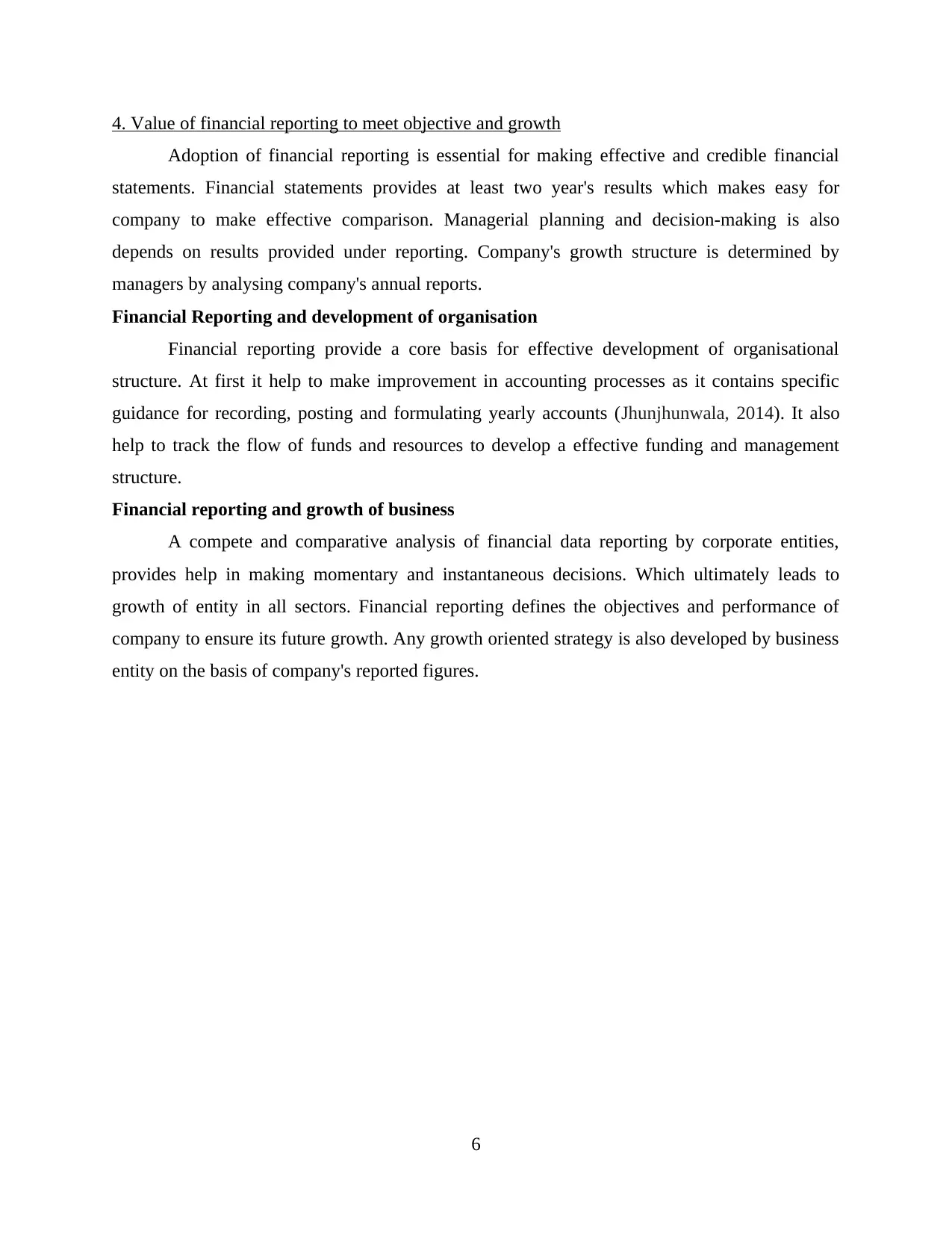
4. Value of financial reporting to meet objective and growth
Adoption of financial reporting is essential for making effective and credible financial
statements. Financial statements provides at least two year's results which makes easy for
company to make effective comparison. Managerial planning and decision-making is also
depends on results provided under reporting. Company's growth structure is determined by
managers by analysing company's annual reports.
Financial Reporting and development of organisation
Financial reporting provide a core basis for effective development of organisational
structure. At first it help to make improvement in accounting processes as it contains specific
guidance for recording, posting and formulating yearly accounts (Jhunjhunwala, 2014). It also
help to track the flow of funds and resources to develop a effective funding and management
structure.
Financial reporting and growth of business
A compete and comparative analysis of financial data reporting by corporate entities,
provides help in making momentary and instantaneous decisions. Which ultimately leads to
growth of entity in all sectors. Financial reporting defines the objectives and performance of
company to ensure its future growth. Any growth oriented strategy is also developed by business
entity on the basis of company's reported figures.
6
Adoption of financial reporting is essential for making effective and credible financial
statements. Financial statements provides at least two year's results which makes easy for
company to make effective comparison. Managerial planning and decision-making is also
depends on results provided under reporting. Company's growth structure is determined by
managers by analysing company's annual reports.
Financial Reporting and development of organisation
Financial reporting provide a core basis for effective development of organisational
structure. At first it help to make improvement in accounting processes as it contains specific
guidance for recording, posting and formulating yearly accounts (Jhunjhunwala, 2014). It also
help to track the flow of funds and resources to develop a effective funding and management
structure.
Financial reporting and growth of business
A compete and comparative analysis of financial data reporting by corporate entities,
provides help in making momentary and instantaneous decisions. Which ultimately leads to
growth of entity in all sectors. Financial reporting defines the objectives and performance of
company to ensure its future growth. Any growth oriented strategy is also developed by business
entity on the basis of company's reported figures.
6
Paraphrase This Document
Need a fresh take? Get an instant paraphrase of this document with our AI Paraphraser
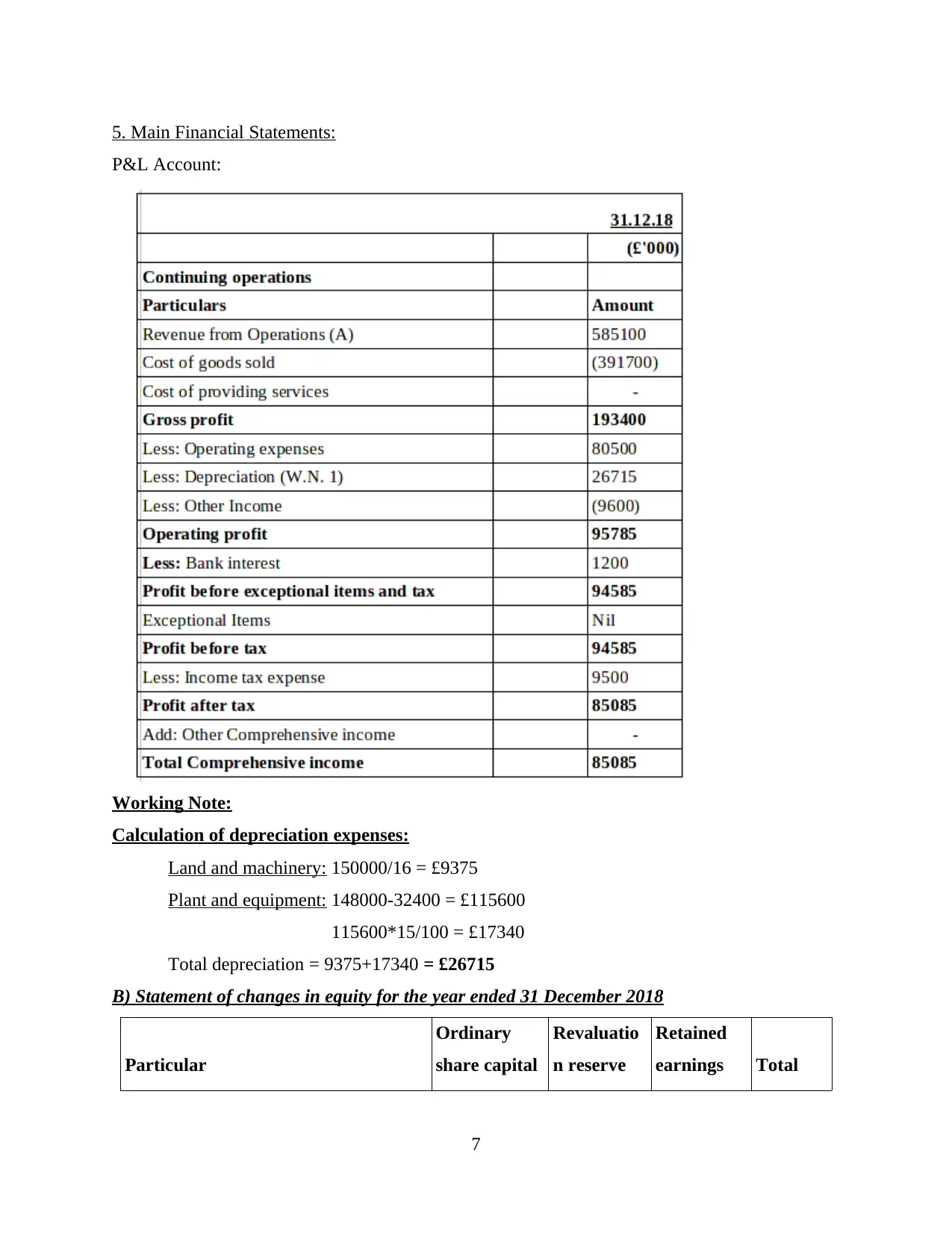
5. Main Financial Statements:
P&L Account:
Working Note:
Calculation of depreciation expenses:
Land and machinery: 150000/16 = £9375
Plant and equipment: 148000-32400 = £115600
115600*15/100 = £17340
Total depreciation = 9375+17340 = £26715
B) Statement of changes in equity for the year ended 31 December 2018
Particular
Ordinary
share capital
Revaluatio
n reserve
Retained
earnings Total
7
P&L Account:
Working Note:
Calculation of depreciation expenses:
Land and machinery: 150000/16 = £9375
Plant and equipment: 148000-32400 = £115600
115600*15/100 = £17340
Total depreciation = 9375+17340 = £26715
B) Statement of changes in equity for the year ended 31 December 2018
Particular
Ordinary
share capital
Revaluatio
n reserve
Retained
earnings Total
7
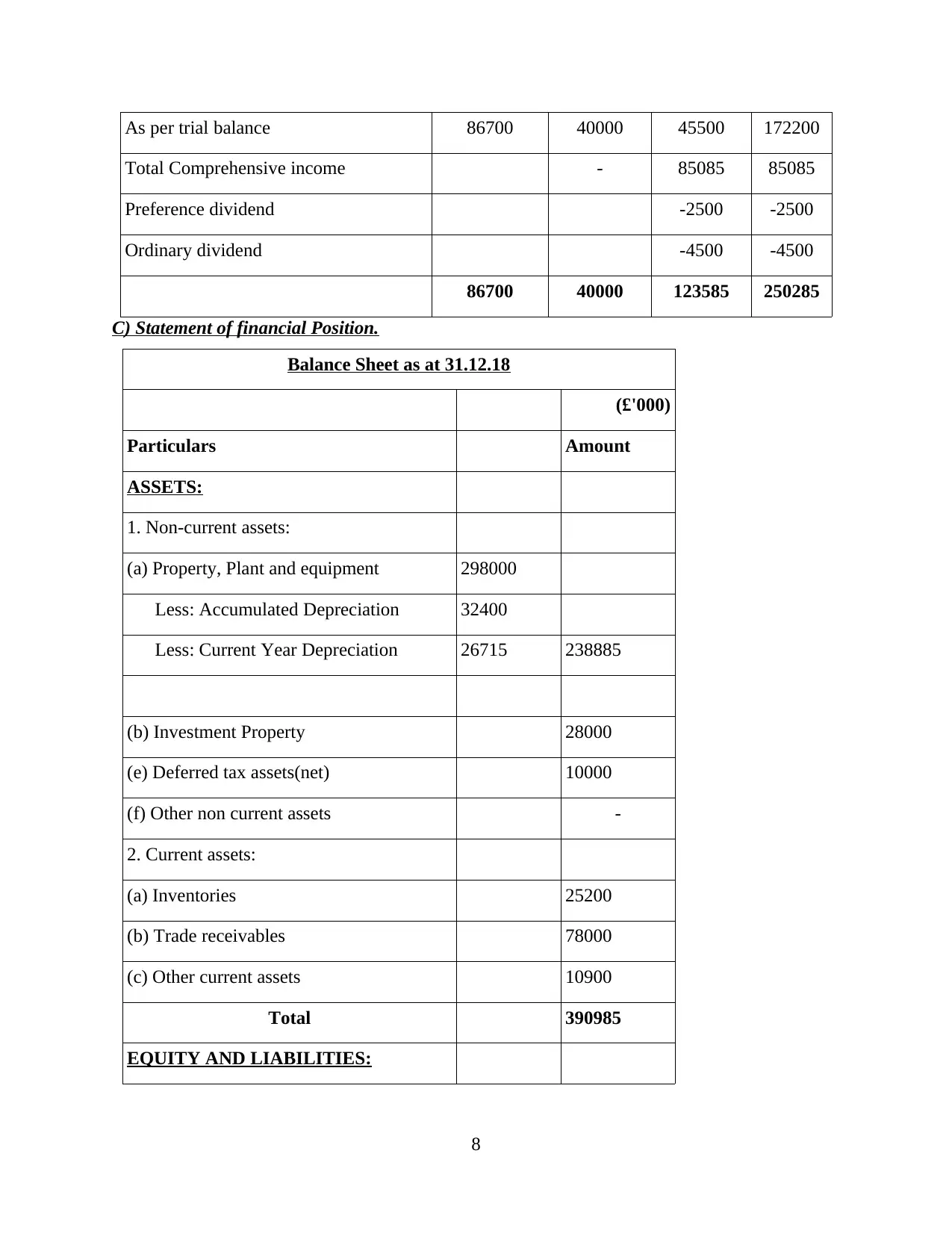
As per trial balance 86700 40000 45500 172200
Total Comprehensive income - 85085 85085
Preference dividend -2500 -2500
Ordinary dividend -4500 -4500
86700 40000 123585 250285
C) Statement of financial Position.
Balance Sheet as at 31.12.18
(£'000)
Particulars Amount
ASSETS:
1. Non-current assets:
(a) Property, Plant and equipment 298000
Less: Accumulated Depreciation 32400
Less: Current Year Depreciation 26715 238885
(b) Investment Property 28000
(e) Deferred tax assets(net) 10000
(f) Other non current assets -
2. Current assets:
(a) Inventories 25200
(b) Trade receivables 78000
(c) Other current assets 10900
Total 390985
EQUITY AND LIABILITIES:
8
Total Comprehensive income - 85085 85085
Preference dividend -2500 -2500
Ordinary dividend -4500 -4500
86700 40000 123585 250285
C) Statement of financial Position.
Balance Sheet as at 31.12.18
(£'000)
Particulars Amount
ASSETS:
1. Non-current assets:
(a) Property, Plant and equipment 298000
Less: Accumulated Depreciation 32400
Less: Current Year Depreciation 26715 238885
(b) Investment Property 28000
(e) Deferred tax assets(net) 10000
(f) Other non current assets -
2. Current assets:
(a) Inventories 25200
(b) Trade receivables 78000
(c) Other current assets 10900
Total 390985
EQUITY AND LIABILITIES:
8
⊘ This is a preview!⊘
Do you want full access?
Subscribe today to unlock all pages.

Trusted by 1+ million students worldwide
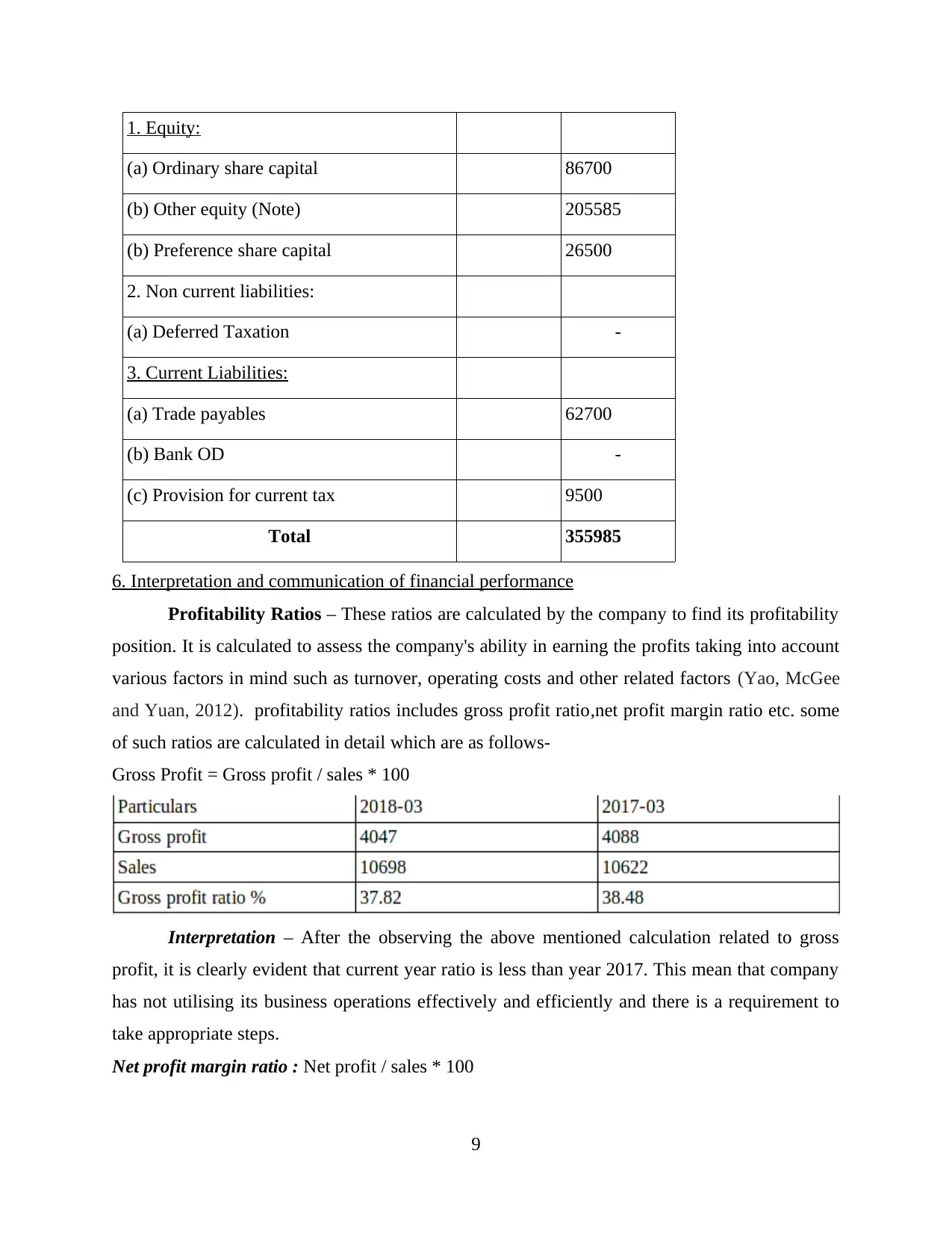
1. Equity:
(a) Ordinary share capital 86700
(b) Other equity (Note) 205585
(b) Preference share capital 26500
2. Non current liabilities:
(a) Deferred Taxation -
3. Current Liabilities:
(a) Trade payables 62700
(b) Bank OD -
(c) Provision for current tax 9500
Total 355985
6. Interpretation and communication of financial performance
Profitability Ratios – These ratios are calculated by the company to find its profitability
position. It is calculated to assess the company's ability in earning the profits taking into account
various factors in mind such as turnover, operating costs and other related factors (Yao, McGee
and Yuan, 2012). profitability ratios includes gross profit ratio,net profit margin ratio etc. some
of such ratios are calculated in detail which are as follows-
Gross Profit = Gross profit / sales * 100
Interpretation – After the observing the above mentioned calculation related to gross
profit, it is clearly evident that current year ratio is less than year 2017. This mean that company
has not utilising its business operations effectively and efficiently and there is a requirement to
take appropriate steps.
Net profit margin ratio : Net profit / sales * 100
9
(a) Ordinary share capital 86700
(b) Other equity (Note) 205585
(b) Preference share capital 26500
2. Non current liabilities:
(a) Deferred Taxation -
3. Current Liabilities:
(a) Trade payables 62700
(b) Bank OD -
(c) Provision for current tax 9500
Total 355985
6. Interpretation and communication of financial performance
Profitability Ratios – These ratios are calculated by the company to find its profitability
position. It is calculated to assess the company's ability in earning the profits taking into account
various factors in mind such as turnover, operating costs and other related factors (Yao, McGee
and Yuan, 2012). profitability ratios includes gross profit ratio,net profit margin ratio etc. some
of such ratios are calculated in detail which are as follows-
Gross Profit = Gross profit / sales * 100
Interpretation – After the observing the above mentioned calculation related to gross
profit, it is clearly evident that current year ratio is less than year 2017. This mean that company
has not utilising its business operations effectively and efficiently and there is a requirement to
take appropriate steps.
Net profit margin ratio : Net profit / sales * 100
9
Paraphrase This Document
Need a fresh take? Get an instant paraphrase of this document with our AI Paraphraser
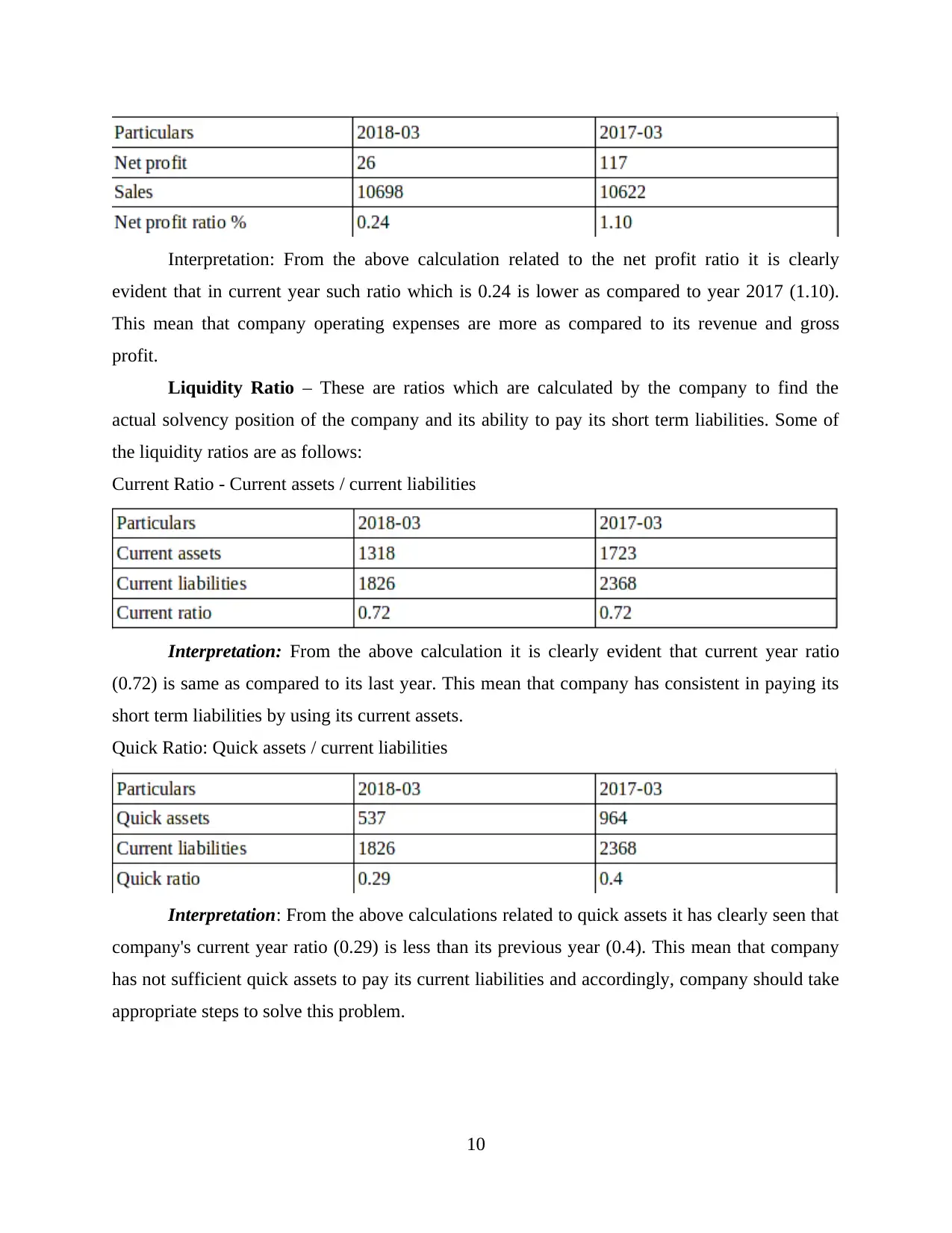
Interpretation: From the above calculation related to the net profit ratio it is clearly
evident that in current year such ratio which is 0.24 is lower as compared to year 2017 (1.10).
This mean that company operating expenses are more as compared to its revenue and gross
profit.
Liquidity Ratio – These are ratios which are calculated by the company to find the
actual solvency position of the company and its ability to pay its short term liabilities. Some of
the liquidity ratios are as follows:
Current Ratio - Current assets / current liabilities
Interpretation: From the above calculation it is clearly evident that current year ratio
(0.72) is same as compared to its last year. This mean that company has consistent in paying its
short term liabilities by using its current assets.
Quick Ratio: Quick assets / current liabilities
Interpretation: From the above calculations related to quick assets it has clearly seen that
company's current year ratio (0.29) is less than its previous year (0.4). This mean that company
has not sufficient quick assets to pay its current liabilities and accordingly, company should take
appropriate steps to solve this problem.
10
evident that in current year such ratio which is 0.24 is lower as compared to year 2017 (1.10).
This mean that company operating expenses are more as compared to its revenue and gross
profit.
Liquidity Ratio – These are ratios which are calculated by the company to find the
actual solvency position of the company and its ability to pay its short term liabilities. Some of
the liquidity ratios are as follows:
Current Ratio - Current assets / current liabilities
Interpretation: From the above calculation it is clearly evident that current year ratio
(0.72) is same as compared to its last year. This mean that company has consistent in paying its
short term liabilities by using its current assets.
Quick Ratio: Quick assets / current liabilities
Interpretation: From the above calculations related to quick assets it has clearly seen that
company's current year ratio (0.29) is less than its previous year (0.4). This mean that company
has not sufficient quick assets to pay its current liabilities and accordingly, company should take
appropriate steps to solve this problem.
10
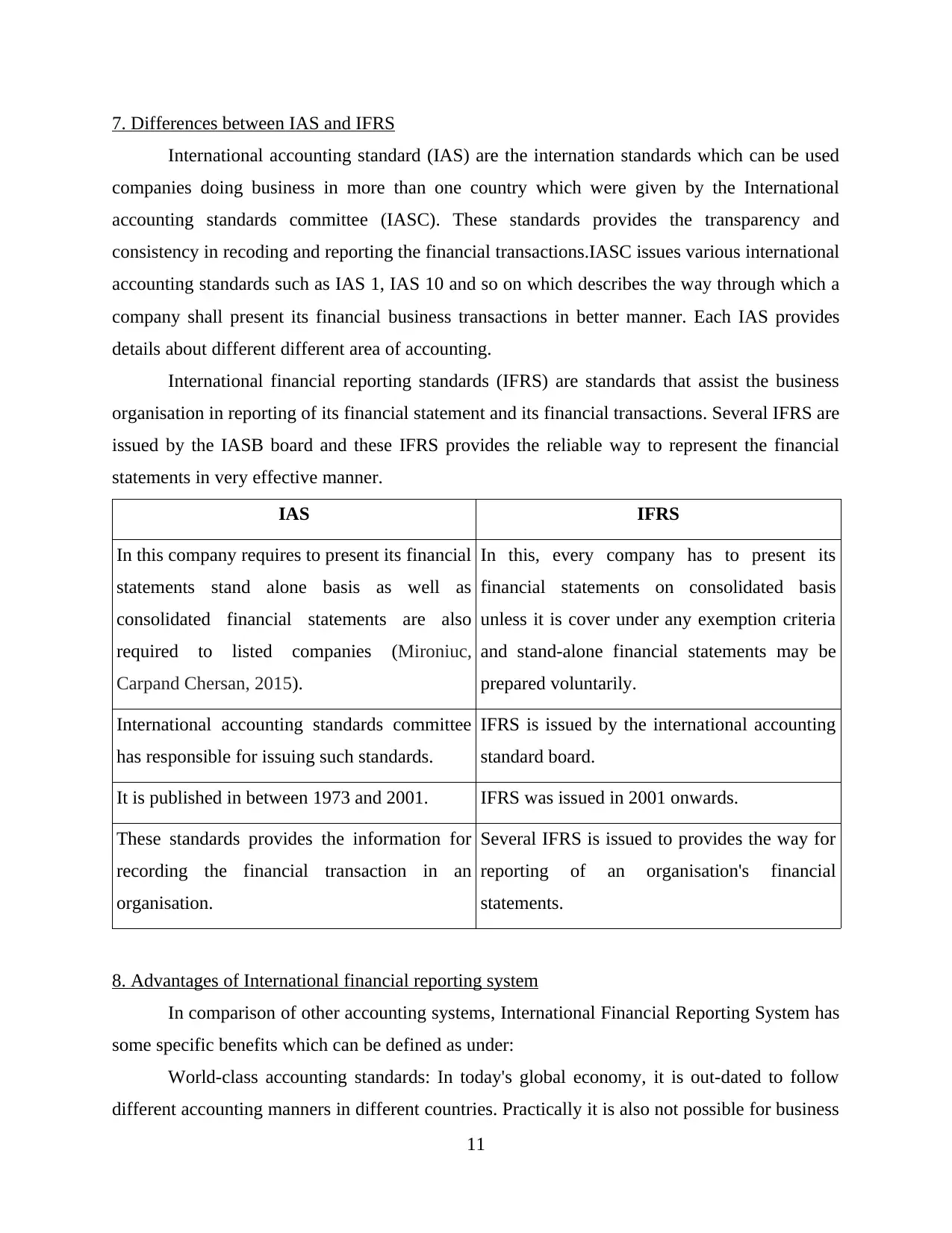
7. Differences between IAS and IFRS
International accounting standard (IAS) are the internation standards which can be used
companies doing business in more than one country which were given by the International
accounting standards committee (IASC). These standards provides the transparency and
consistency in recoding and reporting the financial transactions.IASC issues various international
accounting standards such as IAS 1, IAS 10 and so on which describes the way through which a
company shall present its financial business transactions in better manner. Each IAS provides
details about different different area of accounting.
International financial reporting standards (IFRS) are standards that assist the business
organisation in reporting of its financial statement and its financial transactions. Several IFRS are
issued by the IASB board and these IFRS provides the reliable way to represent the financial
statements in very effective manner.
IAS IFRS
In this company requires to present its financial
statements stand alone basis as well as
consolidated financial statements are also
required to listed companies (Mironiuc,
Carpand Chersan, 2015).
In this, every company has to present its
financial statements on consolidated basis
unless it is cover under any exemption criteria
and stand-alone financial statements may be
prepared voluntarily.
International accounting standards committee
has responsible for issuing such standards.
IFRS is issued by the international accounting
standard board.
It is published in between 1973 and 2001. IFRS was issued in 2001 onwards.
These standards provides the information for
recording the financial transaction in an
organisation.
Several IFRS is issued to provides the way for
reporting of an organisation's financial
statements.
8. Advantages of International financial reporting system
In comparison of other accounting systems, International Financial Reporting System has
some specific benefits which can be defined as under:
World-class accounting standards: In today's global economy, it is out-dated to follow
different accounting manners in different countries. Practically it is also not possible for business
11
International accounting standard (IAS) are the internation standards which can be used
companies doing business in more than one country which were given by the International
accounting standards committee (IASC). These standards provides the transparency and
consistency in recoding and reporting the financial transactions.IASC issues various international
accounting standards such as IAS 1, IAS 10 and so on which describes the way through which a
company shall present its financial business transactions in better manner. Each IAS provides
details about different different area of accounting.
International financial reporting standards (IFRS) are standards that assist the business
organisation in reporting of its financial statement and its financial transactions. Several IFRS are
issued by the IASB board and these IFRS provides the reliable way to represent the financial
statements in very effective manner.
IAS IFRS
In this company requires to present its financial
statements stand alone basis as well as
consolidated financial statements are also
required to listed companies (Mironiuc,
Carpand Chersan, 2015).
In this, every company has to present its
financial statements on consolidated basis
unless it is cover under any exemption criteria
and stand-alone financial statements may be
prepared voluntarily.
International accounting standards committee
has responsible for issuing such standards.
IFRS is issued by the international accounting
standard board.
It is published in between 1973 and 2001. IFRS was issued in 2001 onwards.
These standards provides the information for
recording the financial transaction in an
organisation.
Several IFRS is issued to provides the way for
reporting of an organisation's financial
statements.
8. Advantages of International financial reporting system
In comparison of other accounting systems, International Financial Reporting System has
some specific benefits which can be defined as under:
World-class accounting standards: In today's global economy, it is out-dated to follow
different accounting manners in different countries. Practically it is also not possible for business
11
⊘ This is a preview!⊘
Do you want full access?
Subscribe today to unlock all pages.

Trusted by 1+ million students worldwide
1 out of 15
Related Documents
Your All-in-One AI-Powered Toolkit for Academic Success.
+13062052269
info@desklib.com
Available 24*7 on WhatsApp / Email
![[object Object]](/_next/static/media/star-bottom.7253800d.svg)
Unlock your academic potential
Copyright © 2020–2025 A2Z Services. All Rights Reserved. Developed and managed by ZUCOL.





